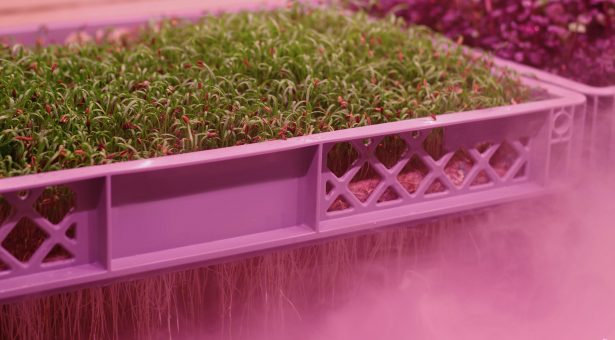Space to grow, or grow in space – how vertical farms could be ready to take-off

Vertical farms with their soil-free, computer-controlled environments may sound like sci-fi, but there is a growing environmental and economic case for them, according to new research laying out radical ways of putting food on our plates.
The interdisciplinary study combining biology and engineering sets down steps towards accelerating the growth of this branch of precision agriculture, including the use of aeroponics which uses nutrient-enriched aerosols in place of soil.
Carried out by the John Innes Centre, the University of Bristol and the aeroponic technology provider LettUs Grow, the study identifies future research areas needed to accelerate the sustainable growth of vertical farming using aeroponic systems.
Dr Antony Dodd, a Group Leader at the John Innes Centre and senior author of the study, says: “By bringing fundamental biological insights into the context of the physics of growing plants in an aerosol, we can help the vertical farming business become more productive more quickly, while producing healthier food with less environmental impact.”
Jack Farmer, Chief Scientific Officer at LettUs Grow and one of the authors of the study, adds: “Climate change is only going to increase the demand for this technology. Projected changes in regional weather patterns and water availability are likely to impact agricultural productivity soon. Vertical farming offers the ability to grow high value nutritious crops in a climate resilient manner all year round, proving a reliable income stream for growers.”
Vertical farming is a type of indoor agriculture where crops are cultivated in stacked systems with water, lighting and nutrient sources carefully controlled.
It is part of a rapidly growing sector supported by artificial intelligence in which machines are taught to manage day to day horticultural tasks. The industry is set to grow annually by 21% by 2025 according to one commercial forecast (Grand View Research, 2019).
Green benefits include better use of space because vertical farms can be sited in urban locations, fewer food miles, isolation from pathogens, reduction in soil degradation and nutrient and water recapturing and recycling.
Vertical farms also allow product consistency, price stabilisation, and cultivation at latitudes incompatible with certain crops such as the desert or arctic.
“Vertical systems allow us to extend the latitude range on which crops can be grown on the planet, from the deserts of Dubai to the 4-hour winter days of Iceland. In fact, if you were growing crops on Mars you would need to use this kind of technology because there is no soil,” says Dr Dodd.
The study, which appears in the journal New Phytologist, lays out seven steps – strategic areas of future research needed to underpin increased productivity and sustainability of aeroponic vertical farms.
These seek to understand:
- Why aeroponic cultivation can be more productive than hydroponic or soil cultivation
- The relationship between aeroponic cultivation and 24-hour circadian rhythms of plants
- Root development of a range of crops in aeroponic conditions
- The relationship between aerosol droplet size and deposition and plant performance
- How we can establish frameworks for comparing vertical farming technologies for a range of crops
- How aeroponic methods affect microbial interactions with plant roots
- The nature of recycling of root exudates (fluids secreted by the roots of plants) within the nutrient solutions of closed aeroponic systems
The report argues that a driver of technological innovation in vertical farms is minimising operation costs whilst maximising productivity – and that investment in fundamental biological research has a significant role.
Dr Dodd’s research area covers circadian rhythms – biological clocks which align plant physiology and molecular processes to the day to day cycle of light and dark. He recently completed a year-long Royal Society Industry Fellowship with LettUs Grow.
This involved combining Dr Dodd’s expertise in circadian rhythms and plant physiology with the work of LettUs Grow’s team of biologists and engineers to design optimal aeroponic cultivation regimens. This is a key area of investigation as these molecular internal timers will perform differently in vertical farms.
Aeroponic platforms are often used to grow high value crops such as salads, pak choi, herbs, small brassica crops, pea shoots and bean shoots. LettUs Grow are also working on growth regimens for fruiting and rooting crops such as strawberries and carrots, as well as aeroponic propagation of trees for both fruit and forestry.
John Innes Centre researchers have bred a line of broccoli adapted to grow indoors for a major supermarket and one of the aims of research will be to test how we can genetically tune more crops to grow in the controlled space of vertical farms.
Bethany Eldridge, a researcher at the University of Bristol studying root-environment interactions and first author of the study adds: “Given that 80% of agricultural land worldwide is reported to have moderate or severe erosion, the ability to grow crops in a soilless system with minimal fertilisers and pesticides is advantageous because it provides an opportunity to grow crops in areas facing soil erosion or other environmental issues such as algal blooms in local water bodies that may have been driven by traditional, soil-based, agriculture.”
Lilly Manzoni, Head of Research and Development at LettUs Grow and one the authors of the study says, “This paper is unique because it is broader than a typical plant research paper, it combines the expertise of engineers, aerosol scientists, plant biologists and horticulturalists. The wonderful thing about controlled environment agriculture and aeroponics is that it is truly interdisciplinary”
The study ‘Getting to the Roots of Aeroponic Indoor Farming‘ appears in the New Phytologist journal.



